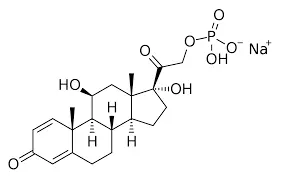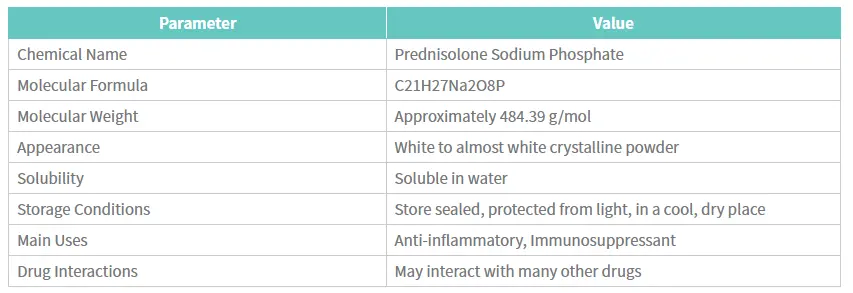It is a strong corticosteroid drug that is used to treat a lot of autoimmune and inflammatory illnesses. As a man-made version of the hormone cortisol that is found in nature, prednisolone sodium phosphate lowers inflammation all over the body and weakens the defense system. This medicine is very adaptable; it can be used to treat both short-term and long-term illnesses that affect many body parts. Asthma, rheumatoid arthritis, inflammatory bowel diseases, and some blood problems are some of the most common conditions it is used to treat. Because prednisolone sodium phosphate can quickly and effectively reduce inflammation, it is a useful treatment choice for many people with painful symptoms. But, as with any strong drug, it needs to be used carefully and under medical guidance because long-term use could cause side effects.

How does prednisolone sodium phosphate work in the body?
Anti-inflammatory effects
Prednisolone sodium phosphate exerts its anti-inflammatory effects by interfering with the body's inflammatory processes at multiple levels. When prednisolone gets into cells, it links to glucocorticoid receptors and changes gene expression. Inflammatory chemicals like prostaglandins and leukotrienes are stopped from being made. It also stops cells that cause inflammation from going to areas that already have inflammation and makes it harder for blood vessels to leak. When these effects work together, they strongly reduce both short-term and long-term inflammatory reactions all over the body. For people with serious asthma or rheumatoid arthritis, this can help relieve their symptoms quickly and significantly.
Immunosuppressive action
In addition to its anti-inflammatory properties, prednisolone sodium phosphate acts as an immunosuppressant by inhibiting the function of various immune cells. The number of T cells that multiply and work lessen, and they are very important to the adaptive immune response. Prednisolone also suppresses antibody production by B cells and interferes with the function of neutrophils, monocytes, and other immune cells. This broad immunosuppressive effect makes prednisolone sodium phosphate useful for treating autoimmune conditions where the immune system is overactive and attacking the body's own tissues. But it also makes infections more likely, so patients need to be closely watched.
Metabolic effects
The metabolism of cells all over the body is greatly affected by prednisolone sodium phosphate. It makes the liver make more gluconeogenesis, which raises blood sugar levels. This can exacerbate diabetes or even induce it in predisposed individuals. When used for a long time, prednisolone can cause muscle loss and weight gain because it breaks down proteins and moves fat around the body. It changes the way bones work, which could eventually lead to osteoporosis. While these metabolic effects are often considered adverse reactions, they can sometimes be leveraged therapeutically. For instance, prednisolone's ability to make you hungry may be useful in treating some conditions that cause you to lose weight.
What are the common respiratory conditions treated with prednisolone sodium phosphate?
Asthma exacerbations
Prednisolone sodium phosphate is an important medicine for treating sudden asthma attacks. When patients experience severe asthma attacks that do not respond adequately to inhaled medications, oral or intravenous prednisolone can provide rapid relief. It works by lowering inflammation and hyperresponsiveness in the lungs, which opens up the airways and makes breathing better. A typical course for an asthma exacerbation might involve a high dose of prednisolone for 5-7 days, followed by a gradual taper. This short-term, intensive treatment can often prevent hospitalization and speed recovery. For patients with severe persistent asthma, low-dose daily prednisolone may sometimes be prescribed as a maintenance therapy to control symptoms and prevent exacerbations.
Chronic obstructive pulmonary disease (COPD)
In patients with COPD, prednisolone sodium phosphate is primarily used to treat acute exacerbations. During a COPD flare-up, increased inflammation in the airways can lead to worsening breathlessness, cough, and sputum production. Taking prednisolone for a short time can help lessen this inflammation, which can make symptoms better and improve lung function. It might also help keep people out of the hospital or shorten their time there. Long-term use of oral corticosteroids is not usually suggested for steady COPD, though, because they can cause side effects. The decision to use prednisolone in COPD exacerbations should be based on the severity of symptoms and the patient's individual response to treatment.
Interstitial lung diseases
A lot of people with interstitial lung diseases need to be treated with prednisolone sodium phosphate. These are diseases that cause inflammation and damage in the lung tissue. Steroid treatment often works well for conditions like sarcoidosis, hypersensitivity pneumonitis, and some types of idiopathic interstitial pneumonia. This is when prednisolone works to stop the inflammation processes that hurt the lungs. Treatment plans can be very different based on the condition and how bad it is. They can be as short as a few weeks for acute flare-ups or as long as years of maintenance therapy. While prednisolone can be very effective in managing these conditions, careful monitoring is essential due to the potential for serious side effects with prolonged use.
Can prednisolone sodium phosphate be used to treat skin conditions?
Atopic dermatitis and eczema
Prednisolone sodium phosphate can be an effective treatment for severe or widespread atopic dermatitis and eczema that do not respond adequately to topical treatments. Its potent anti-inflammatory effects can quickly reduce itching, redness, and swelling associated with these conditions. A short course of oral prednisolone may be prescribed to control acute flare-ups, providing rapid relief and allowing the skin to heal. However, long-term use is generally avoided due to potential side effects. Instead, prednisolone is typically used as a bridge therapy while other treatments, such as topical corticosteroids or immunomodulators, are optimized. It's important to note that while prednisolone can provide quick relief, it does not address the underlying causes of atopic dermatitis and should be used as part of a comprehensive management plan.
Severe allergic reactions
It is very important to use prednisolone sodium phosphate to treat serious allergic skin reactions like angioedema or severe urticaria. In these cases, the rapid anti-inflammatory and antihistamine-like effects of prednisolone can be life-saving. It helps to lessen the redness, itching, and other signs of severe allergic reactions. For acute episodes, a short course of high-dose prednisolone may be prescribed, often in combination with antihistamines. In some cases of chronic urticaria that doesn't respond to antihistamines alone, low-dose prednisolone may be used as a temporary measure. However, due to the risk of side effects, long-term use is generally avoided, and alternative treatments are sought for ongoing management.
Autoimmune skin disorders
Prednisolone sodium phosphate is a valuable treatment option for various autoimmune skin disorders. Conditions such as pemphigus, bullous pemphigoid, and severe forms of lupus erythematosus often respond well to systemic corticosteroid therapy. In these disorders, prednisolone works by suppressing the overactive immune response that leads to skin damage. Treatment regimens can vary widely depending on the specific condition and its severity. For acute flares, high doses of prednisolone may be used initially, followed by a gradual taper. In some cases, long-term low-dose therapy may be necessary to maintain remission. However, due to the potential for serious side effects with prolonged use, dermatologists often aim to use the lowest effective dose and may combine prednisolone with other immunosuppressive medications to minimize steroid exposure.
Conclusion
helped with many different kinds of sickness and fire problems. For many reasons, like helping with skin and breathing issues, it has become an important part of health. Regardless, the benefits of using it must be carefully weighed against the risks, especially if it is used for a long time. As research goes on, more targeted treatments may come out, but for now, prednisone is still used as the main drug for a lot of difficult medical conditions.
At Xi'an Salis Biological Co., Ltd., we are committed to producing high-quality APIs like prednisolone sodium phosphate to support global healthcare needs. Our strict quality control measures and state-of-the-art facilities make sure that the goods we send out meet the highest international standards. For more information about our products or to discuss your API needs, please contact us at lea_slsbio@163.com,WhatsApp+86 13193326505.

FAQ
Q: How quickly does prednisolone sodium phosphate start working?
A: Prednisolone typically begins to take effect within a few hours, with maximum benefits often seen within 1-2 days.
Q: Can prednisolone sodium phosphate be used long-term?
A: While it can be used long-term for some conditions, prolonged use increases the risk of side effects and should be carefully monitored by a healthcare provider.
Q: Are there any dietary restrictions while taking prednisolone?
A: Patients on prednisolone are often advised to limit sodium intake and ensure adequate calcium and vitamin D to protect bone health.
Q: Can prednisolone interact with other medications?
A: Yes, prednisolone can interact with many medications, including blood thinners, diabetes medications, and certain antibiotics. Always inform your doctor of all medications you're taking.
Q: Is it safe to stop taking prednisolone suddenly?
A: No, prednisolone should usually be tapered off gradually under medical supervision to avoid withdrawal symptoms or flare-ups of the underlying condition.
References
1. Barnes PJ. Glucocorticoids. Chem Immunol Allergy. 2014;100:311-316.
2. Cain DW, Cidlowski JA. Immune regulation by glucocorticoids. Nat Rev Immunol. 2017;17(4):233-247.
3. Rhen T, Cidlowski JA. Antiinflammatory action of glucocorticoids--new mechanisms for old drugs. N Engl J Med. 2005;353(16):1711-1723.
4. Schäcke H, Döcke WD, Asadullah K. Mechanisms involved in the side effects of glucocorticoids. Pharmacol Ther. 2002;96(1):23-43.
5. Strehl C, Buttgereit F. Optimized glucocorticoid therapy: Teaching old drugs new tricks. Mol Cell Endocrinol. 2013;380(1-2):32-40.
6. Vandewalle J, Luypaert A, De Bosscher K, Libert C. Therapeutic Mechanisms of Glucocorticoids. Trends Endocrinol Metab. 2018;29(1):42-54.

